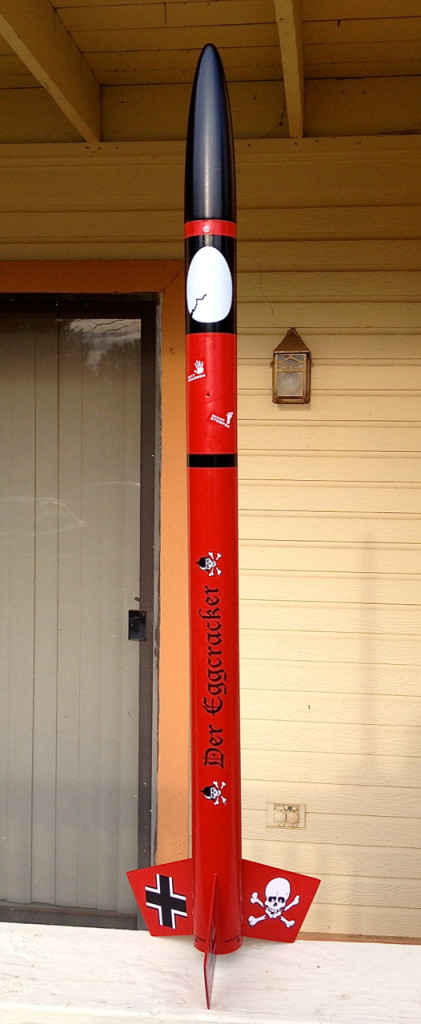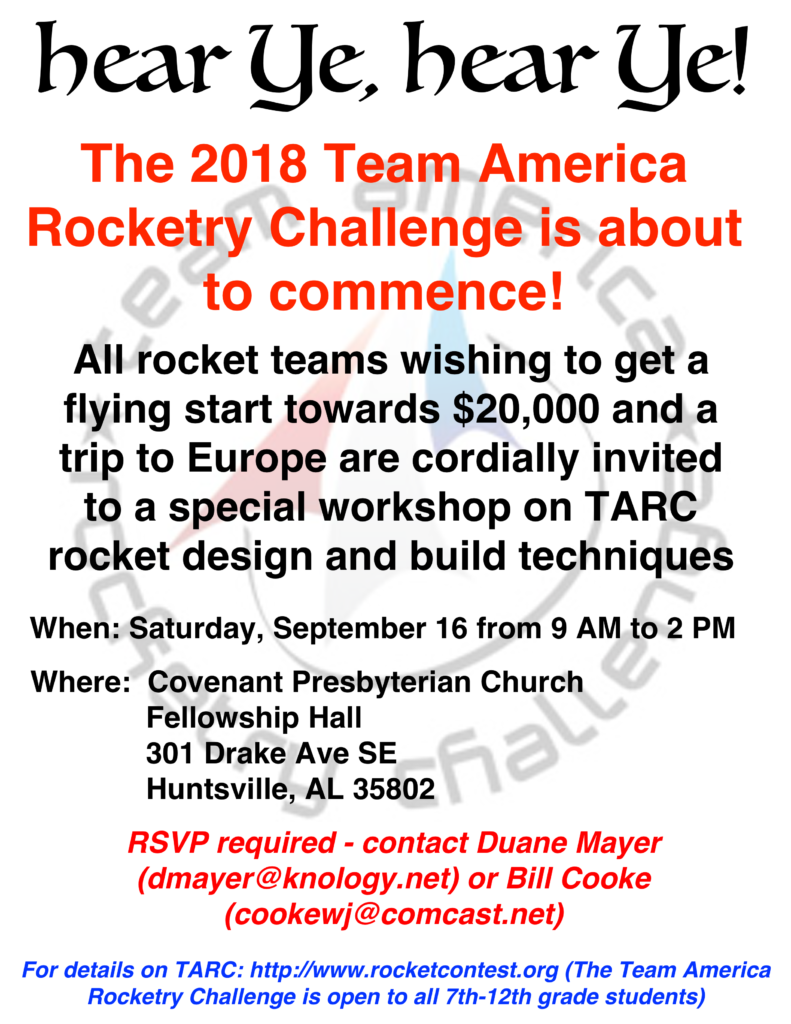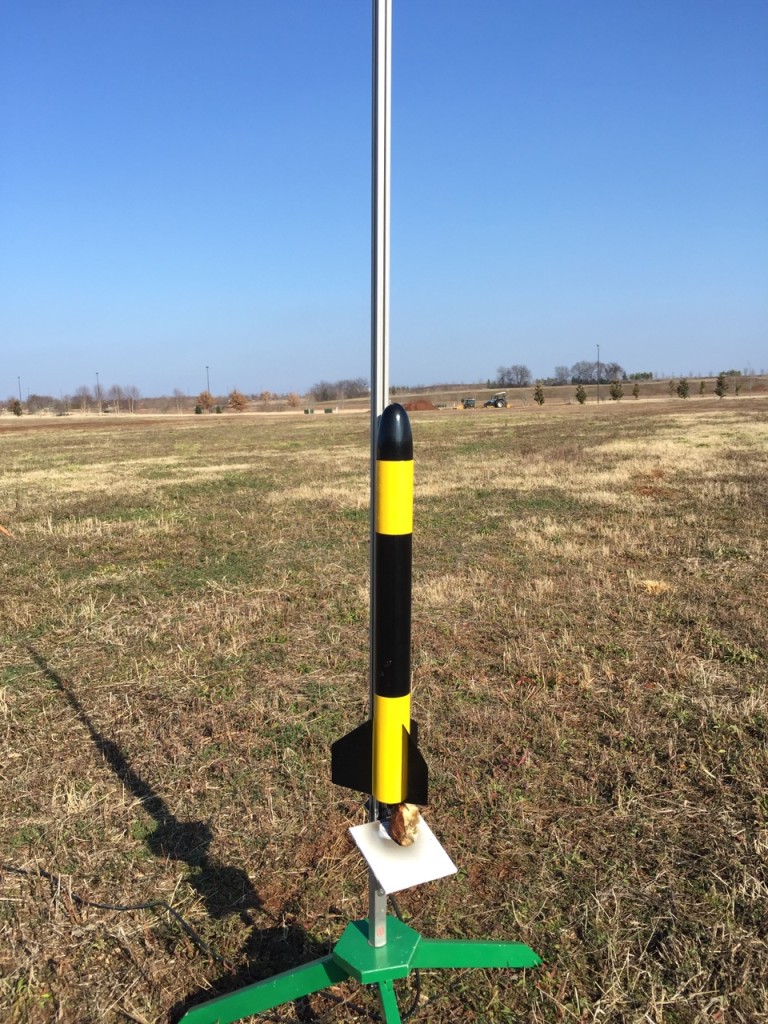Archive for Bill
2018 TARC Workshop – September 16
Meeting Agenda for this Thursday, July 6
Got a few things to discuss:
- Southern Thunder 2017 recap
- Status of Manchester field; field search
- Equipment status; Rail and cart purchases
- Upcoming July events, including MOU event at USSRC
- Upcoming TARC season (Workshop set for September 16 at ETF)
- Membership
And a starter set giveaway!
See ya’ll at 7:30 pm!
Manchester launch rescheduled for May 13
Moved because of weather scrub on May 6
May 6 launch scrubbed…
The May 6 launch in Manchester is scrubbed due to very poor weather prospects.
Geezer TARC is about to commence…
Geezer TARC, HARA’s version of TARC for “older” rocketeers begins with the announcement of the 2016 TARC challenge at Nationals this weekend. It is open to any interested rocketeer over 21, and provides an excellent way for TARC mentors (or potential TARC mentors) to get a feel for the difficulties that will be faced by their teams in the upcoming months.
Standard TARC rules for 2016 season will apply, except for the following:
1) Geezer TARC begins with the announcement of the 2016 rules in May and ends with the contestants’ rockets being launched at a single event (date TBD, but well before school starts in late summer).
2) Each contestant may enter up to two rockets. These rockets may not fly before the official launch date, and the score shall be determined by the first flight of each on that date. The contestant’s score shall be the better of the two flights, or the score of one flight if only one rocket is entered.
3) Any commercial altimeter may be used to determine altitude. However, reflights are not allowed if there is an altimeter malfunction; in this case, the flight will be disqualified (So choose a reliable altimeter).
4) There is only one rocket per design, and there are no test or sub-scale flights permitted for the design. Its merit will be judged solely by the rocket’s performance at the contest launch. If two rockets are entered, they must be of substantially different design – different number of motors, fins, or something major – an inch shorter or taller does not constitute a substantial difference, nor does the same design at a different scale (e.g., BT-70 versus BT-80 versions).

Der Eggcracker – a minimum diameter TARC rocket. This one was too efficient; it went WAY over altitude.
In the past, we have launched at a horse farm in Harvest. This year’s launch will probably be at “Pegasus field” in Research Park in Huntsville or at a HARA launch in Manchester. The launch will take place in late July or early August, and yes, you must be there to fly. That’s part of the contest – we want to witness what happens! We will try to pick a date that will be agreeable to all schedules.
Geezer TARC measures your ability to design an rocket to meet the TARC challenge – there are no proxies or test flights, as this would defeat the purpose. There is only one rocket for each design, and its first flight will be at the launch. If you enter two rockets, each must be based on a different design (like “Sure Thing” versus “Hail Mary”). This is a major part of the fun of the contest – we spend a lot of time designing a rocket to meet the challenge, but will it do it without modifications, on the first flight?
Good luck, and see you on the field!
The Huntsville TARC Regionals
Today was a good day to fly…
At least 9 TARC teams converged on Bragg Farms just north of Huntsville for our annual TARC regional launch.
Estes on steroids
by Bill Cooke
Mention Estes to a rocketeer these days, and you usually get a smirk; they are famous for Ready-To-Fly (RTF) and other easily built low power kits. Not much thrill to many in flying birds using 13 mm, 18mm, and 24 mm motors (1/4 A to E impulse). But that’s changing… Read more
Rocket Design/Simulation Programs for TARC
by Bill Cooke
TARC is like the real world of rocket design in that the teams must resort to design/simulation software to help flesh out the initial concept, making sure it can meet the goals before pressing on to actual construction/testing. Here the vendors have come to the rescue in providing three outstanding packages, any one of which can be used to design a winning TARC entry. Read more
Thoughts on the 2013 TARC challenge
by Bill Cooke
NAR and the AIAA have just released the objectives for the 2013 TARC season. In brief, they are
- Altitude mark of 750 feet
- Flight Duration of 48-50 seconds
- 15″ parachute must be used to recover the egg and the altimeter
- Egg must be placed horizontally (“lying on its back”)
- Section of rocket containing the egg must be at least 60 mm (2.362″) in diameter
- Gross liftoff weight of under 650 grams
- Motor impulse must be 80 newton-seconds or less
At first glance. this seems simple; after all, each of these has been used in past years. No surprises, so pretty easy challenge for the TARC teams, right? Read more
Pack 351 Rocket Blast – and indeed it was!
by Bill Cooke
Every year Cub Scout Pack 351 has their annual ‘rocket blast’, in which the cubs fly rockets they have recently bought or built. HARA – in the form of Chuck Pierce and various others who show up to assist – always provides the launch setup and range control, which has been fairly easy for the past couple of years due to the use of the USSRC/Space Camp launch facilities. Read more





